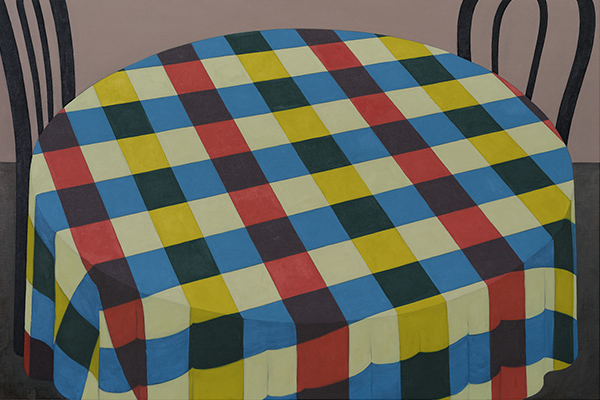2022
Time Life, Karma, New York, 2022
“Volume 1. Foods of the World” is the first of seven “volumes” in Mungo Thomson’s Time Life series. Each is a stop-motion video animation that Thomson assembled from images he spent years taking of different books on a particular theme. Calling to mind a shotgun marriage between a flipbook and an e-book, each video-volume speeds along to a (mostly) percussive score. “Foods of the World” is the longest, at 12:09 minutes, and establishes a discipline that subsequent volumes follow and from which they also depart. These are concert works, theme and variation. “Foods of the World” sets the table. It represents Thomson’s most explicit address of books as a medium and digitization as an animating concern. Created between 2014 and 2022 and based on titles published by Time-Life between 1968 and 1989, “Foods of the World” is less a single chronological slice of media (or food) history than it is a prismatic meditation on knowing, making, and seeing in a world once analog and now increasingly digital.
Thomson is a creature of media-theoretic paradox. His videos manage to look retro but without hint of nostalgia. They signal energetic futurity but without whisper of applause.
“Foods of the World” opens with ©, or rather with hundreds of pictures centered on the symbol © as it appears in the copyright declarations of Time-Life books. Animated at 10 frames per second, © hovers hypnotically for more than half a minute, a constant amid fragments of accompanying text that fly by. Prelude to an onrush of images that capture illustrations, recipes, and many more fragmentary page elements, opening with © supports Thomson’s video-as-volume conceit at the same time that it celebrates his adaptive reuse of published materials in making art. (His first four video-volumes use Time-Life books, while the others range further afield.) Later the words “To make” hover in place amid an animated sequence of printed recipes (e.g., “To make 12 stuffed peppers”). The materials Thomson uses in Volume 1 are taken from books in series like Foods of the World (1968) and Great Meals in Minutes (1984).
As its name suggests, the Time-Life imprint (1961–2003) was a division of the magazine publisher Time Inc., and the sibling relationship between books and magazines was key to the business model. Potential readers subscribed to a series of books—clothbound, lavishly illustrated—and then individual volumes arrived periodically through the mail. Series topics tended toward useful knowledge, like cooking, health and fitness, gardening, home repair, or other ostensibly self-improving knowledge bases, like history, geography, and the arts. The vibe was encyclopedic—promising mastery of a subject—and collecting complete matching sets of books must have been part of the appeal.
Time Inc. had an aspirational middle-class clientele in mind. The more elevated Book of the Month Club (acquired by Time Inc. in 1977) advertised in the New York Times Book Review, but Time-Life advertised its wares extensively on television. Its target audience was a white-bread America primed to value efficiency (“great meals in minutes”) and armchair worlding (“foods of the world”). Making a “world picture” characterizes the project of modernity itself, according to philosopher Martin Heidegger, and Time Inc. clearly got the memo. Time magazine pitched efficiency with the slogan, “Take Time – It’s Brief,” while Life magazine hawked worlding with its slogan “To see Life; to see the world.”
Thomson’s “Foods of the World” starts the way so many books do, with ©, but it ends like cooking shows on TV, with a sequence of plated foods. In between Thomson probes the kinds of book-based tutelage on offer. Sequences that focus on illustrations of food preparation are juxtaposed to sequences that animate the spiral-bound recipe booklets that accompanied each of the Foods of the World volumes. We see hands stir, fold, whisk, shuck, truss, carve, crush, roll, frost, sauté, etc. And we see snatches of spiral-bound pages of text. Thomson’s camera lavishes particular attention on the spiral bindings of these recipe booklets, the twisting wire coils a perfect image of continuousness amid the discrete logic of individual page elements. Later, in “Volume 6. The Working End,” Thomson spotlights a similar continuousness as his stop-motion technique animates images taken of books that illustrate how to tie knots. Each frame has an inner logic—two hands holding rope(s) being tied—and each has an outer logic: the edges of the picture, a bit of surrounding page, sometimes even glimpses of the background against which Thomson worked. Inside and outside hail each other throughout Thomson’s work, as if asking forever and again, call and response, (how) is a scan of a page (also) somehow that page? And (how) is a scan of a picture (also) somehow that picture?
The visual-auditory onrush of Thomson’s videos evokes a workflow that we can imagine as part of today’s large-scale book digitization projects, where page by page, bit by bit, the analog corpus is inexorably reborn as digital assets, usually with corporate strings attached. The hands that stir so many pots and tie so many knots can even call to mind the hands of Google subcontractors fleetingly glimpsed amid its book scans. Stirring hands are part of the inner logic—making stuffed peppers—only they hint visually of other, outer making by Thomson.
Everything is going to be digitized. So we are encouraged to believe, as even the Internet Archive (not to mention Google again) promises universal access to all knowledge. “Everything.” “All.” Time Inc. may have promised its subscribers the world, but we are worlding by smartphone and laptop these days, subscribing to platforms instead of periodicals. The world picture on offer by Time Inc. was a world keyed to the perspectives of mainstream America, and surely it’s worth worrying that the world on offer today—so-called everything—might likewise be skewed.
What won’t be digitized? What can and can’t be digitized? Thomson reconnoiters the questions of can and can’t as he tests what books are and what they do. For “Volume 5. Sideways Thought,” he assembled approximately 4,000 illustrations of works by sculptor Auguste Rodin and captured them against a black background. Because the individual works by Rodin have been photographed from so many different angles, Thomson’s stop-motion capture can make Rodin’s figures appear to writhe and rotate. At 8 frames per second, bronzes come almost to life, where “almost” hinges on the visual play of 2D and 3D as well as the contours of the art historical corpus as it has variously pursued mastery of Rodin. In “Volume 7. Color Guide,” the images Thomson mobilizes—over 2,000 of them—are all taken from a recent Pantone Color Formula Guide. Individual color swatches—this time without framing page or background—pulse along to an original score by Los Angeles musician Adrian Garcia, as if to ask, (how) is a scan of a color also that color?
Documenting works by Rodin, like illustrating meals or establishing color standards, is a matter of visual fact. To that end, each swatch in “Color Guide” actually is the color that it displays, but only if we somehow take account of Pantone’s own printing process (attaching ink to paper), Thomson’s camera specs (creating digital files), and the color-tolerances of our video display technology (and our eyes). Color is a visual fact of visual media. Like other such facts it is at once amplified and attenuated in its transit from print through digitization to display. Thomson queues up these findings first in “Volume 3. Flowers (Nahbild).” Here Thomson captures floral illustrations from Time-Life gardening books, a riot of color into which his camera appears to descend. Zoomed-in we see the individual dots and spaces of the four-color halftone process that Time-Life used to print its books. What from a distance appears as gradient (continuous), is revealed as discrete elements. What looks like flowers turns out to be composed of a zillion arbitrary bits. Halftone dots evoke the pixel in Thomson’s ken, as analog and digital lock together in an eternal, layered play of contrasts.
Time Life was shown recently at Karma in New York City (March 5–April 16, 2022), where all seven videos were projected in sequence against one wall of the gallery. At monumental scale Thomson’s work has an unmistakable urgency to it, not to elicit either cheers or tears but rather to compel reflection. Time Life asks us to consider the future archive of accumulating pasts, an archive admittedly so massive, so grandiose, that it’s hard to clock in just how partial, how fragmentary, it will necessarily be. Visual treasures abound: our impulse is to make a world of them.



